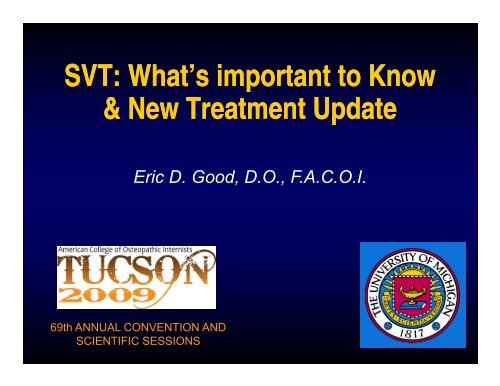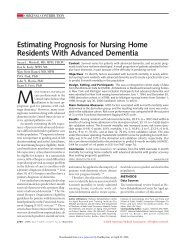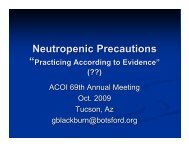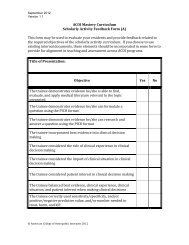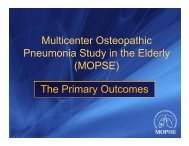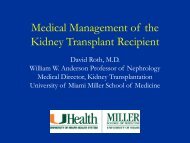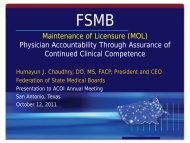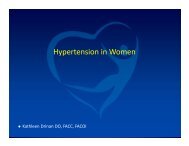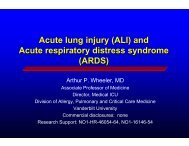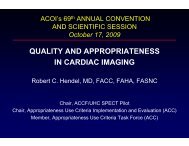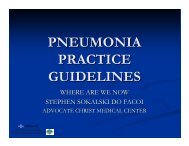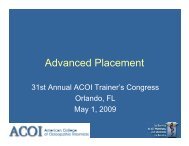SVT: What's important to Know & New Treatment Update
SVT: What's important to Know & New Treatment Update
SVT: What's important to Know & New Treatment Update
You also want an ePaper? Increase the reach of your titles
YUMPU automatically turns print PDFs into web optimized ePapers that Google loves.
<strong>SVT</strong>: What’s <strong>important</strong> <strong>to</strong> <strong>Know</strong>& <strong>New</strong> <strong>Treatment</strong> <strong>Update</strong>Eric D. Good, D.O., F.A.C.O.I.69th ANNUAL CONVENTION ANDSCIENTIFIC SESSIONS
Disclosures:• Speaking honoraria for CME programs & research:– Medtronic– Bos<strong>to</strong>n Scientific (Guidant)– Biosense-Webster• Research/grant support:– Medtronic– Bos<strong>to</strong>n Scientific (Guidant)– Biotronik– Atritech
GOALS OF PRESENTATION• Utilize a case-based approach <strong>to</strong> identify keyfeatures of the patient his<strong>to</strong>ry, clinical presentationand ECG that help diagnose the mechanism ofcommon <strong>SVT</strong>s.• Relate general concepts about EP studies and theablation of supraventricular arrhythmias.• Discuss new technologies utilized in diagnosis andtreatment of <strong>SVT</strong>s.
Supraventricular TachycardiaSinus tachycardia (ST)Inappropriate sinus tachycardia (IST)Sinoatrial nodal reentrant tachycardia (SNRT)Atrial tachycardia (AT)Multifocal atrial tachycardia (MAT)Atrial fibrillation (AF)Atrial flutter (AFl)Junctional ec<strong>to</strong>pic tachycardia (JET)Nonparoxysmal junctional tachycardia (NPJT)Atrioventricular nodal reentrant tachycardia (AVNRT)Atrioventricular reentrant tachycardia (AVRT)
CASE: DE• 27 y/o female with c/o palpitations & “racingheart” for “years”• Sudden-onset, termination• Sometimes break with straining• Associated SOB, dizziness• Normal labs (TSH), stress echo & 24 hr holter 3yrs ago• Dx with “anxiety” & Rx prn alprazolaml• Now more frequent episodes, pre-syncope• No significant other PMHx
Clinical Clues• Absence of stuctural heart disease• Sudden or gradual onset• Precipitating it ti fac<strong>to</strong>rs• Regularity of rhythm• Frequency, duration• Termination: Vagal Maneuvers• Severity of symp<strong>to</strong>ms: Syncope
CASE: DEWhat Do You Do Next?1. Order repeat echocardiogram2. Tell her: “it’s all in your head, you just need <strong>to</strong>relax more” & increase alprazolam <strong>to</strong> TID3. Treat empirically with BBl4. Send for EP study5. Order an event moni<strong>to</strong>r
External Event Moni<strong>to</strong>r:• Worn for extended period(21-28 days)• Office or home hook-up• Manual & au<strong>to</strong>-triggertiactivation• Cell transmission, internetaccessibility• Acute alert notifications• Pt can mail back• $$$ (may be costly)
External Event Moni<strong>to</strong>r:CPT Codes:• 93270 ECG Memory Looping Recorders (hook up)• 93272 ECG Memory Looping Recorders (review andinterpretation)• 93014 ECG Non-Looping Recorders (review andinterpretation)t ti • 93225 ECG Digital Holter Recorders (hook up)93227 ECG Di i l H l R d ( i d• 93227 ECG Digital Holter Recorders (review andinterpretation)
Implantable Loop Recorder:
CASE: DE
CASE: DENCT 12-lead in ED:
CASE: DESinus 12-lead in ED:
P<strong>SVT</strong>-Most Common Mechanisms• AV node reentry 70%• AP-mediated 25%• Atrial tachycardia 5%
Electrocardiographic Clues:• Narrow QRS tachycardia (usually)• Characterize short-RP, long-RP• Onset, termination• Effect premature beats<strong>SVT</strong>
Typical, Atrioventricular Nodal Reciprocating Tachycardia(AVNRT)Washing<strong>to</strong>n Heart Rhythm Associates, LLCUpToDate, 2005
A1A2: 500/320 ms- Block in FP, ConductionThrough SP, Induction of AVNRTAH 260
Typical AVNRT:UpToDate, 2005
Atypical AVNRT:UpToDate, 2005
Atypical AVNRT:
<strong>Treatment</strong> Strategies AVNRT:• Acute tachycardia– Vagal maneuvers– Adenosine– CV (hemodynamically unstable)• Medical therapy– AV nodal agents, particularly BBl– Sometimes class IC AARx• Catheter ablation is mainstay– Efficacy approaches 98% in many centers– Complications
<strong>New</strong> Ablation Technologies:Indian Pacing Electrophysiol. J. 2008; 8 (Suppl. 1): S75-S91
CASE: MW• 28 y/o G1P0 female at 20 wks gestationpresents <strong>to</strong> ED with c/o sudden-onsetpalpitations, i “racing heart” & chest pain• Normal prenatal exams, otherwise healthy• Taking only prenatal multivitamin• No prior PMHx• Rapid irregular HR & BP 95/56 on exam• Following ECG obtained
CASE: MW
1. Immediate CV 360JCASE: MW2. Bolus 150 mg IV Amiodarone3. Call for stat Cards/EP consult4. Bolus & IV qtt procainamide5. Exclaim “I remember this was on the boards,but I never thought I’d ever really see it!,” thenimmediately go buy a Mega-Millions Lotteryticket
CASE: MW
VentricularPreexcitation
Accessory AV Connection
Orthodromic Reciprocating TachycardiaAVNAP
ECG Clues Suggestive ofOrthodromic Reciprocating• Rate >200 bpmTachycardia• P wave in ST segment• QRS alternans• AV or VA block during tachycardiaexcludes ORT as mechanism
Orthodromic ReciprocatingTachycardia
PW Wave in STS Segment tin V2
Orthodromic ReciprocatingTachycardia:QRS Alternans240 bpm
Antidromic Tachycardia
Antidromic Tachycardia: Left-Sided AP220 bpm
Sinus with Pre-excitation,PAC initiating i i i ORT
Orthodromic Reciprocating Tachycardia:Drug TherapyFlecainidePropafenoneQuinidineProcainamideDisopyramideSotalolAmiodaroneAVNAPAdenosineBeta-blockersCalcium channel blockersDigitalisSotalolAmiodarone
Pre-excited AFib After 12 mg Adenosine225 bpm
CASE: MW1. Keep in hospital on IV Procainamide2. Take emergently <strong>to</strong> C-section3. Transition <strong>to</strong> quinidine & moni<strong>to</strong>r throughpregnancy4. Transition <strong>to</strong> amiodarone & moni<strong>to</strong>r throughpregnancy5. Transition <strong>to</strong> beta-blocker & moni<strong>to</strong>r throughpregnancy
Pregnancy: Class IA Drugs• Quinidine• Longest record of safe use in pregnancy (60y)• Secreted in breast milk but ok <strong>to</strong> nurse (AAP)• Case reports of thrombocy<strong>to</strong>penia, premature labor,CN VIII <strong>to</strong>xicity• Disopyramide – initiation of premature labor• Should not use• Procainamide• No tera<strong>to</strong>genic effectsec • Acute treatment of arrythmia• Not as much experience as quinidine• No longer available orally
Pregnancy: Class IC• Limited experience• Relatively safe• Cross placenta• Flecanide used for fetal <strong>SVT</strong>• Ok <strong>to</strong> breast feed
Pregnancy: Beta Blockers• Used extensively for HTN and hyperthyroidismyand are well <strong>to</strong>lerated• Reports of IUGR, bradycardia in fetus,hypoglycemia• Mechanistic risk of decreased uterine relaxation(beta 2)decreased placental flowincreasedfetal PVR• no firm evidence that non-selective ect e agents areworse but use of selective agents recommended• Not first line treatment for arrhythmia
Pregnancy: CCB• 1stst line for AVNRT and Idiopathic VT• Verapamil• May impair i uterine contractions ti if used longterm• Diltiazem• Not as much experienceMaternal hypotension may occur with IV dosing
CASE: MW• Managed on quinidine SR 324 mg twice daily• No recurrence AFib or <strong>SVT</strong>, only palpitations• Intrauterine pregnancy at 37-1/7th weeks'gestation• Footling breech presentation and spontaneousrupture of membranes• C-section, delivered healthy 2640-gm maleinfant• Taken <strong>to</strong> EPS-RFA 9 mos later• Post-Lat AP successfully ablated, no recurrencey ,<strong>to</strong> date
Radiofrequency Ablationof an Accessory PathwayRF on
CASE: MW
RF Ablation of AP’s in 1,242 PatientsUniversity of Michigan• Mean Age-• Acute Success 96%• Procedure Time37 ± 15 yrs100 ± 35 min• Fluoro Time40 ± 30 min• Recurrence 3%• Long term Success 95%
Complications of RFA of AP’s• Death 0.08% *• Cardiac Tamponade0.5%• AV Block 0.5%• Femoral artery complication 0.5%• Coronary artery spasm 0.2%• Pericarditis 01% 0.1%• TIA 0.1%*3 of 4000 pts at 5 centers
“<strong>New</strong>” Ana<strong>to</strong>mical Relationships:Septal AP, close <strong>to</strong> HIS
“<strong>New</strong>” Ana<strong>to</strong>mical Relationships:Better timing from NCC Aorta
28 y/o man with WPW, Hx of AF, rate 250/min
Coronary Sinus Venogram
Transpericardial Access:
Position o of Effective Pericardial Target SiteRelative <strong>to</strong> Right Coronary Artery0° AP 40° LAO
Delivery of RF Energy in Pericardial Space(4-mm tip, 40 watts, temp 55-60)* *
<strong>SVT</strong>: Re-entrant mechanism• AV Nodal Re-entryentry• AP-mediated Re-entry (ORT, ART)• Atrial Tachycardia (Au<strong>to</strong>matic)
CASE: JH• 20 y/o female with no PMHx presents withasymp<strong>to</strong>matic, incessant tachycardia <strong>to</strong> PCPfor evaluation of dysuria/UTI• Echocardiogram with LVEF = 20%• Negative ischemic, congenital w/u• No CHF Sx
CASE: JH12-lead ECG
CASE: JH1. Start BBl, ACEi/ARB, spironolac<strong>to</strong>ne and orderf/u echocardiogram 6 mos2. Schedule TEE-CV3. Initiate appropriate Rx & Send for EPS ± RFA4. Order event moni<strong>to</strong>r5. Send for ICD evaluation
CASE: JH
Tachycardia-Induced Cardiomyopathyy• Incessant <strong>SVT</strong>s • abnormal calciumhandling• Afib• depletion of myocardial• AflutterATP• PVCs• downregulation of β-1• VTrecep<strong>to</strong>rs• Myocardial stunning fromoxidative stress*** HIGH INDEX OF SUSPICION is key <strong>to</strong> diagnosis ***
Transseptal Puncture with ICERALA
Focal Atrial Tachycardia (FAT)
Termination FAT during RF
Incidence of FAT by site:(independent d of LA RFA)Kistler et al. JACC 2006(48)5:1010-1017.Series of 126 consecutive patientsTang C, Scheinman M, et al.JACC 1995(26)5:1315-13251325.Series of 31 consecutive patients
IIIBase of RAA:IIIaVRaVLFATSinusaVFV1V2V3V4V5V6AT/48M
Focal atrial tachycardia originating from the epicardialleft atrial appendageYamada et al. Heart Rhythm 2008;5:766 –767.
<strong>SVT</strong> after AFib RFA:
Macro-reentrant <strong>SVT</strong> post-Afib RFA:(Atypical atrial flutter)• Large circuit (>2-3 cm)• Bound by ana<strong>to</strong>mic orfunctional barriers <strong>to</strong>conduction• Frequently multi-looped• Atrial conduction timeaccounts for most of thecycle length AT (90%)• Target is critical isthmusof conductionChae et al. JACC 2007. (50)18:1781-1787.
Focal Atrial Tachycardia post-Afib RFA:(FAT)• Isoelectric segment between p-waves• 1:1 atrial conduction?• Adenosine sensitivity?• Centrifugal activation awayfrom small area• Atrial conduction time does notaccount for entire cycle lengthAT• Target earliest activation• Focal application terminatestachycardia abruptly at SOO
Left Atrial Focal TachycardiaPA projectionRSPVLSPVLIPVRIPVMitral AnnulusIIAblCS
Atrial Tachycardia After CircumferentialPulmonary Vein Ablation of Atrial FibrillationChae et al. JACC 2007. (50)18:1781‐1787.• Incidence:– 10‐30% PAF ablations– 25‐50% CAF ablationsMicro-re-entry(14%)FAT(12%)Macro-re-entry(75%)• 155 ATs mapped, 78 pts– 88% Re‐entry– 12% Focal
Mapping of Atrial Tachycardia AfterAblation of Atrial FibrillationChae et al. JACC 2007 (50)18:1281‐1287.Critical isthmus in 96% LA reentrant ATs traversed a priorablation line, consistent with a gap-related mechansim
<strong>SVT</strong> after CAF RFA:JB/63M
<strong>Treatment</strong>s for AT post AF RFA:• AV nodal blocking agents may not help• Class IC anti-arrhythmics may make things worse• Patients t often feel worse than Afib• Early, repeated CV probable benefit (unpublisheddata)• Early repeat ablation?
Chugh et al. Heart Rhythm (2008). Pub Pending.JB/63M
Chugh et al. Heart Rhythm (2008). Pub Pending.JB/63M
CASE: DO• 56 y/o male with hx of OHT 20 yrs prior (bi-atrialanastamosis)• Multiple co-morbidities, including CRF• Presents with tachycardia & hypotension duringHD, stable BP otherwise• Following ECG obtained
CASE: DO12-lead ECG
CASE: DO1. Administer adenosine with 12-lead ECG2. Immediate 360J unsynchronized CV3. Bolus & start on IV lidocaine4. Submerge patient’s head in a bucket of ice-waterand tell them “it’s for your own good!”5. Do nothing, sign-out patient <strong>to</strong> your partner oncall& let him/her make the decisions for once
Case DO:12 mg IVP Adenosine
Two Heart Beat As One:RECIPIENT’S ATRIUMTRANSPLANTED ATRIUM
Two Hearts Joined As One:SuperiorVena CavaPurple: <strong>New</strong> HeartMulti-colors:Old HeartTricuspidValveInferiorVena CavaView of Right Atria
Biatrial Ortho<strong>to</strong>pic Heart Transplant:Recipient’s Heart(Atrium)Donor Heart(Transplanted Atrium)Suture LineMorgan and Edwards. J CARD SURG. 2005;20:103
Catheter Ablation:
Summary• Identified most common <strong>SVT</strong>s & theirmechanisms as presented in unique clinical casevignettes– AV Nodal Re-entrant– AP-mediated– Atrial Tachycardia/ Atrial Flutters• Discussed various treatment t t options, focus onemerging diagnostic & ablative therapies• Identified “Novel” <strong>SVT</strong>s (LA AT/AFL) as a product• Identified Novel <strong>SVT</strong>s (LA AT/AFL) as a produc<strong>to</strong>f AFib ablation procedures & discussedtreatment options
ACC/AHA/ESC 2003 Practice Guidelines:Management <strong>SVT</strong>
Ei Eric D. Good, DOD.O.Assistant Professor,Interventional Cardiac ElectrophysiologyDepartment of Internal MedicineDivision of Cardiovascular MedicineUniversity of MichiganContact t information:•Office: 734-763-7392•Fax: 734-936-7026•Email: dogood@umich.edu


